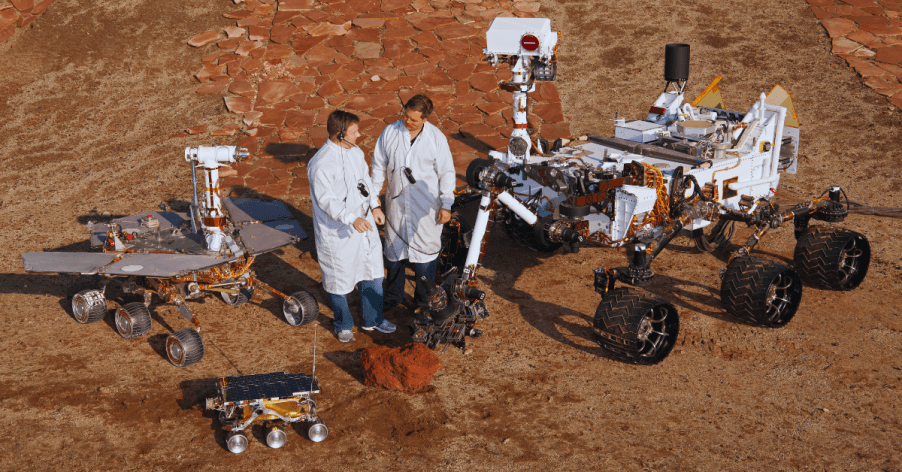
15 Iconic Spacecraft That Helped Advance Space Exploration

After several space missions, humanity has made outstanding discoveries like colliding galaxies, black holes, and lakes of liquid methane. These missions increased our understanding of life in the cosmos, inspiring generations to dream bigger and reach further. However, exploration has only been possible because of these 15 iconic spacecraft!
Apollo 11

Approximately 650 million people watched live as Neil Armstrong landed on the moon alongside Buzz Aldrin and Michael Collins. As Armstrong stepped on the moon, he declared, “That’s one small step for [a] man, one giant leap for mankind.” Apollo 11 isn’t just the most notable spacecraft; it was a significant leap in space exploration.
SOHO (Solar and Heliospheric Observatory)

ESA and NASA built the Solar and Heliospheric Observatory to observe solar activity. Since launching on December 2, 1995, it has monitored space weather, predicted solar storms, and detected over 3,000 comets. Despite being 1.5 million km from Earth, SOHO has successfully reshaped our understanding of the Sun and its effects on Earth.
Galileo

Galileo landed on Jupiter and became the first space probe to orbit an outer planet. It also discovered evidence of subsurface oceans on Europa and Callisto. Notably, Galileo directly observed a rare phenomenon of a comet colliding with a planet (Shoemaker-Levy 9). When the mission concluded in 2003, it was destroyed to prevent contaminating Europa.
Sputnik 1

The Soviet Union stunned the world when it launched Sputnik 1 on October 4, 1957. As the first-ever artificial Earth satellite, this spacecraft was revolutionary! Its intense radio pulses were detected by amateur radio operators worldwide. The launch remains a historic event because it boosted space exploration as world powers tried to outdo each other.
Chandra X-ray Observatory

The Chandra X-ray Observatory is the most powerful X-ray telescope ever built, with eight times greater resolution than previous builds. Thanks to its 25-meter elliptical orbit with uninterrupted observations of about 55 hours, we’ve seen sharp images of black holes, supernova remnants, and galaxy clusters. As of 2024, Chandra is one of the longest-operating observatories.
Juno

Unlike previous missions that relied on nuclear energy, Juno entered orbit on July 4, 2016, using solar power. NASA launched this spacecraft on a trailblazing mission to study Jupiter, so it orbits Jupiter every 53 days. Today, we understand Jupiter’s evolution better, including the formation of huge planets and their function in the solar system.
Lunar Reconnaissance Orbiter (LRO)

After a decade of absence from Luna (Earth’s moon), NASA launched Lunar Reconnaissance Orbiter (LRO) on June 18, 2009. This time, the special spacecraft covered 98.2% of the lunar surface with high-resolution cameras. It identified safe landing sites, potential water ice resources, and footprints of Apollo astronauts. Undoubtedly, LRO’s data would help future lunar exploration.
Kepler Space Telescope

NASA launched the Kepler Space Telescope on March 6, 2009, to monitor 150,000 stars in the constellation Cygnus. Its 1-meter-diameter telescope found planets and discovered over 2,300 exoplanets, some as big as Earth. Because of Kepler, humankind now knows there are more planets than stars in our galaxy, which is surprising but true.
International Space Station (ISS)

The ISS proves that collaborative efforts can achieve remarkable advancements in space exploration. 15 countries built the ISS, which has been continuously occupied since November 2000. While orbiting the Earth every 90 minutes, the ISS has hosted over 3,000 research investigations from over 108 countries, enabling scientific breakthroughs in biology, physics, astronomy, and microgravity.
Viking 1

NASA’s Viking 1 was the first US spacecraft to land on Mars successfully. After it touched down in 1976, it transmitted over 4,500 detailed images of the Martian surface. These photos kickstarted the search for life on Mars. Likewise, Viking 1 took the first soil samples analyzed on another planet during its six-year operation.
Mars Rover Curiosity

This NASA spacecraft is the largest rover ever sent to Mars to establish whether it can support life. After landing in 2012, Curiosity started investigating the climate, geology, and habitability. It soon found evidence of ancient freshwater environments. As of September 2024, Curiosity has spent 12 years on Mars, far exceeding its original 2-year mission.
New Horizons

In 2015, New Horizons traveled over 3 billion kilometers to Pluto—the farthest any spacecraft has traveled for a flyby. Horizons continued to the Kuiper Belt in 2019, flying by Arrokoth (2014 MU69) to become the first to visit at such a distance. Its missions produced unprecedented images and data about the planet and its moons.
Pioneer 10

Pioneer 10 is the first spacecraft to journey beyond Mars and traverse the outer solar system. In case it finds extraterrestrial life, this spacecraft carries a plaque showing human figures and our solar system’s location. Before its last signal in 2003, Pioneer 10 crossed the asteroid belt in 1972 and made its closest approach to Jupiter in 1973.
Cassini-Huygens

In 2005, the Huygens probe landed on Titan, Saturn’s largest moon, marking the first landing in the outer solar system. This spacecraft is considered groundbreaking because it succeeded in extensively studying Saturn and its moons. Before Cassini’s mission ended on September 15, 2017, humans came across liquid methane lakes on Titan and water-ice geysers on Enceladus.
Hubble Space Telescope

Since NASA launched this spacecraft, our knowledge of astronomy has grown exponentially. Hubble has provided data for over 15,000 scientific papers, including high-resolution images from low Earth orbit. It also found supermassive black holes and the universe’s accelerating expansion. Hubble remains active because astronauts have serviced it up to five times since 1990.


